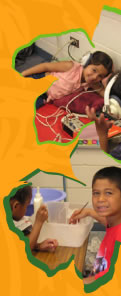Executive Summary
Project Status
During the initial seven months of year one activity, the project aligned it’s start-up with the completion of SIG I activities, as being conducted through a no-cost extension of SIG I activities. Also, SIG II project staff established all logistical and collaborative linkages required to initiate work toward goals and activities as proposed for SIG II. The project got off to a fast start and made scheduled program progress with staff and partners in place from the SIG I grant personnel structure. Delays, typical of a new project, were experienced with the establishment of a fiscal and personnel structure for the project and with the processing of memorandum of agreement with project partners. Despite the fiscal and personnel processing delays, project staff and partnering personnel were able to move forward with planning, development, and implementation activities in line with year one expectations.
The resources of the SIG II grant are being focused upon improving the quality of capacity, both system capacity and personnel capacity, to improve educational outcomes for children and youth with disabilities. With the focus upon improving quality, first year activities of the project focused upon a single school district/complex (Waianae Complex) allowing staff to hone in specific professional development and improvement strategies to support teachers and other school level personnel as they identified and sought to implement/test new strategies for working with children with disabilities. This approach required the formation and implementation of school based learning communities within the Waianae Complex of seven schools, focused upon identifying and testing new strategies and methods (both school-wide and classroom based). During the first seven months of the SIG II the seven learning communities were in place and functioning as proposed. Personnel development support for the seven learning communities was proposed to be provided by a district/complex level professional development team—while the professional development team was in place for the district/complex, delays in hiring a coordinator for the team (with project funds) led to lack of coordination of support activities as provided to the school level learning communities— while activity progressed the project was unable to provide the level of guidance and monitoring anticipated—as hiring is completed this need will be readily addressed and any delays will be caught up.
State level partnership activities progressed as planned with the use of state level personnel and partners, who were prepared to participate, given extensive involvement in the grant preparation process. The state level partners met numerous times during the first seven months of funding to hammer out work-scopes and agreements for numerous memos of agreement being developed. These meetings have focused upon ensuring that partner activity is aligned and integrated within the overall plans to support the work of learning communities at project schools—this effort has produced work-plans that ensure alignment of activity and outcome, focused upon the desires and needs of participating school sites to improve strategies and services leading to improved educational outcomes for children with disabilities. An example of this coordination can be seen in the planning activities of PTI, Part C Program, and university partners as they develop strategies to improve parent and community communication and participation in a school with this targeted need. As PTI and Part C Program partners work with the school learning community, partnering university material developers follow their discussions closely, thus ensuring that materials for the site have a high accessibility and utilization value in the targeted demonstration school, as well as school/communities statewide. To ensure quality collaboration and highly effective products and resulting outcomes, Year one activities to date have focused upon building relationships and working partnerships so that planned strategies and products reflect the strengths and expertise/experience of all participants.


